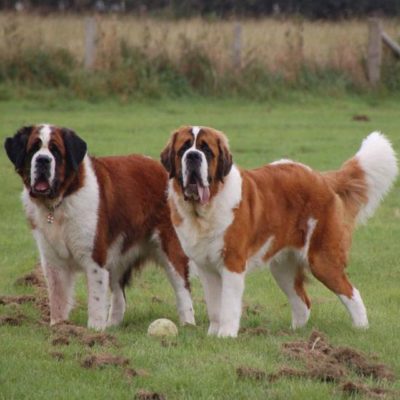St. Bernard
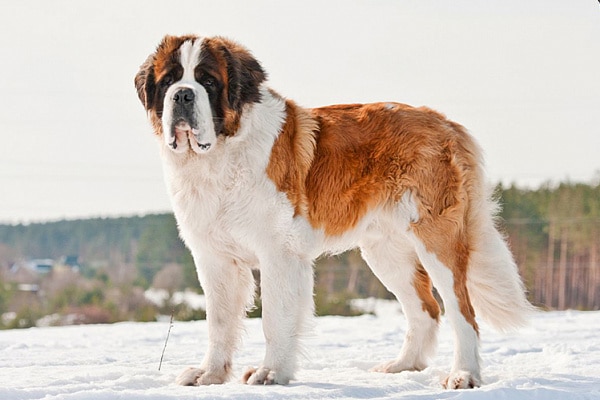
If you want a loyal friend who will save you from any trouble, then St. Bernard is the best choice. He will do a great job as a watchman, helper, and just a loyal companion. Because of its size, St. Bernard will feel more comfortable in the home. What is noteworthy, the breed is very protective of children.
Table of Contents
Breed Information
| Another Name | Saint Bernhardog, St. Bernhardshund, Bernhardiner, Alpine Spaniel |
| Origin | Switzerland |
| Height | Males 70-90 cm Females 65-80 cm |
| Weight | 63-80 kg |
| Fur | Short or long |
| Color | Red with white marks or white with red marks |
| Lifespan | 8-11 years |
| FCI Classification | Pinscher and Schnauzer – Molossoid and Swiss Mountain and Cattledogs |
| Group | Protection dogs, guard dogs |
| Price | From $200 |
Breed Photos
Origin History
The pedigree history of the breed is unusual. Several versions have come down to us, which are confirmed by the historical facts of the time. The first theory is that the name of the breed, which means “St. Bernard’s dog,” comes from a monk named Bernard, who served in a monastery in the Swiss Alps. He founded the shelter of the same name for guests, which is located on the pass of the Great St. Bernard at an altitude of about 2472 meters. By the end of the seventeenth century, the area was one of the most densely populated at such an altitude. It is believed that it was the monks of this shelter in 1670 who gave some dogs to farmers, and from there began the spread of the breed. The second version is as follows: St. Bernard is the result of a cross between Tibetan mastiffs, which were brought some time ago to Europe, and local dogs that live near the mountains.
The monks used St. Bernards as allies when they went into the valley. They then realized how well developed the dogs’ sense of smell was and how well Saint Bernards were adapted to the cold and snow. It was the most reliable companion who could easily find victims under blockages of snow and anticipate an impending avalanche. From 1800 to 1812, a St. Bernard named Barry (also called: “Barry the Rescue,” hence another possible name for the breed) was able to save about 40 lives. There was a case when Barry found a tiny child under the debris of snow and carried him more than 5 km in the snow to the monastery. So good-natured and brave are the dogs of the breed when it comes to saving people.
The official name of the breed was adopted in 1880. The breed grew in popularity by 1887, when the first Saint Bernard Club was created. By 1960, St. Bernard had become one of the most popular species in the United States, where the breed is used as a guard dog and companion dog. And some St. Bernards have even been awarded medals of valor for successful rescues.
Appearance
St. Bernard is fascinating to look at. It is a beautiful, giant dog with a kind heart and a confident look. The head is large. The forehead is convex, which is slightly covered with wrinkles. The upper lips are sagging. Powerful and robust neck. The ears are medium-sized, floppy. The coat is possibly long and short, with a dense undercoat (mostly a dark “mask” on the muzzle and the predominance of white in the overall coloration). The tail is long, extended at the base.
Character
If you want a loyal friend who will save you from any trouble, then St. Bernard is the best choice. He will do a great job as a watchman, helper, and just a loyal companion.
Because of its size, St. Bernard will feel more comfortable in the home. What is noteworthy, the breed is very protective of children. Will behave calmly and protect the child from everything and everyone. Towards other animals neutrally, the only thing you need to watch out for the reaction to small breeds of dogs because St. Bernard is a dimensional dog. St. Bernard justifies the name “sacred dog” because he will be the soul of any family.
Care
As mentioned earlier, St. Bernard is not the best dog to keep in an apartment. The dog needs a large area. Its thick skin and heavy coat will survive the cold wonderfully and suffer from the heat. The coat is supple, does not become tangled in tangles; comb it preferably 1-2 times a week. Vulnerable place in the dog – the eyes. St. Bernards develop eye diseases and infections. Take care of and inspect the eyes daily. Clean the ears regularly. Frequent water treatments are unnecessary; they will be bad for the coat, bathe as your pet gets dirty.
Training
St. Bernard has excellent composure. It is a very obedient and balanced dog who will try to please its owner. Because of its kind heart and gentle temperament, St. Bernard will work for you and please you with its results. Start training at an early age, be patient, and don’t demand everything at once. Make your dog trust you and feel at ease. Don’t get nervous or shout at him, but encourage him if he fails miserably and, of course, praise him for every success.
Common Diseases
Despite its strong immunity, the breed is prone to some diseases:
- stomach problems, stomach congestion, and bloating (occurs in the case of an improperly chosen diet);
- inflammatory eye processes (cataract, cherry eye, everted or everted eyelids);
- epilepsy;
- deafness;
- diseases of joints and ligaments.
Nutrition
St. Bernards are not fussy about food, but they tend to be overweight, so don’t overfeed your beloved pet. Choose a healthy, nutritious diet where everything is in moderation. Remember, puppy and adult dog nutrition is different. It’s preferable to feed your puppy about six small meals a day. For an adult, two standard meals per day are sufficient. An adult dog needs at least 0.5 kilograms of pure meat a day + cereals; St. Bernards also do not mind eating vegetables. When it comes to food, it is better to consult experienced breeders, who will help you with your choice. Dry food needs about 1 kg per day.
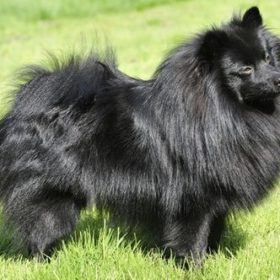 German Spitz
German Spitz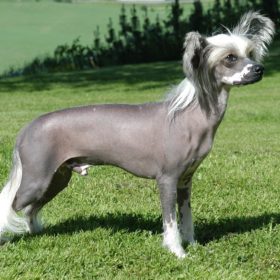 Chinese Crested Dog
Chinese Crested Dog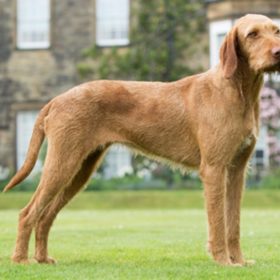 Wirehaired Vizsla
Wirehaired Vizsla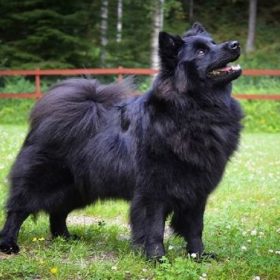 Swedish Lapphund
Swedish Lapphund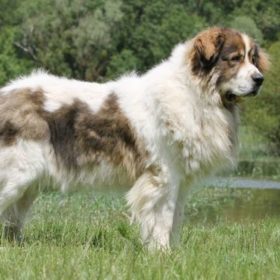 Pyrenean Mastiff
Pyrenean Mastiff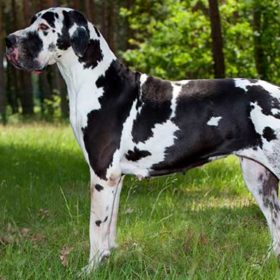 Great Dane
Great Dane
